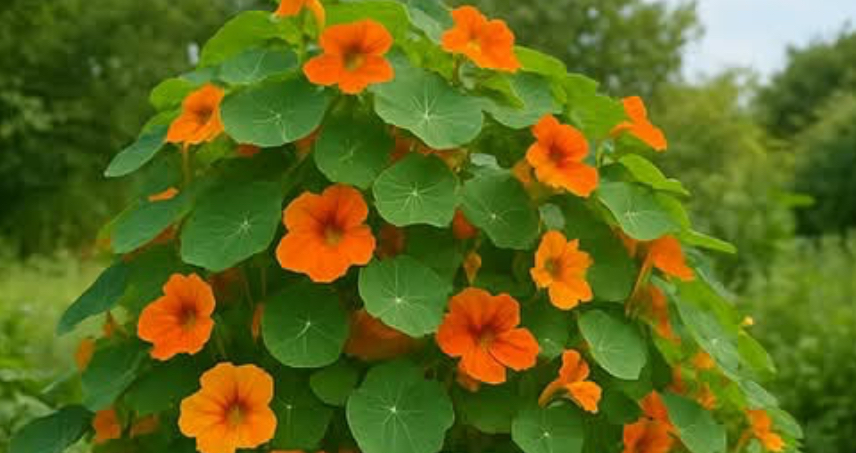Why Nasturtiums Are a Garden EssentialNasturtiums (Tropaeolum majus) are low-maintenance plants that thrive in diverse conditions, making them ideal for both novice and seasoned gardeners. Their vibrant flowers, lush green leaves, and practical benefits make them a triple threat in beauty, functionality, and nutrition. Here’s why they’re a must-have.🌿 Natural Pest ControlNasturtiums act as a “trap crop,” attracting pests like aphids, caterpillars, and whiteflies, keeping them away from delicate plants like tomatoes, cucumbers, and peppers.🐝 Attracts PollinatorsTheir bright blooms draw bees, butterflies, and beneficial insects, boosting pollination and increasing yields for crops like squash and berries.🌱 Thrives with EaseNasturtiums flourish in poor soil, require minimal care, and are drought-tolerant, making them perfect for low-maintenance gardens or containers.🌸 Edible and FlavorfulEvery part—flowers, leaves, and seeds—is edible, offering a peppery, arugula-like flavor that elevates salads, dishes, and garnishes.🥗 Nutrient-Rich Health BoostHigh in vitamin C, antioxidants, and minerals like iron and calcium, Nasturtiums support immunity, fight cell damage, and promote overall wellness.🦠 Antibacterial and AntifungalTheir natural antimicrobial properties make them a traditional remedy for minor infections and skin issues.How to Use Every Part of NasturtiumsNasturtiums are a culinary delight, with each part offering a unique peppery taste. Here are three ways to incorporate them into your meals.1. Nasturtium Flowers for Colorful Garnishes 🌸Add a spicy, vibrant touch to your dishes.How to Use:🥄 Toss whole flowers into salads for a pop of color and flavor.🌱 Garnish soups, appetizers, or main dishes with fresh blooms.🍽️ Stuff flowers with soft cheeses like goat cheese for a stunning appetizer.2. Nasturtium Leaves for Savory Dishes 🥗Enhance meals with their zesty bite.How to Use:🥄 Add chopped leaves to salads, sandwiches, or wraps for a peppery kick.🌱 Blend into pesto with nuts, garlic, and olive oil for a spicy twist.🍳 Mix into omelets or frittatas for an herbaceous flavor boost.3. Nasturtium Seeds as a Caper Substitute 🧂Turn seeds into a tangy condiment.How to Use:🥄 Pickle green seeds in vinegar to make “poor man’s capers” for salads or sauces.🌱 Add to marinades for meats or veggies for extra tang.🧵 Grind dried seeds into a peppery spice for roasted vegetables.Growing and Caring for NasturtiumsNasturtiums are beginner-friendly and thrive with minimal effort. Here’s how to grow them successfully.🌞 Planting TipsPlant seeds in spring after the last frost, or start indoors 2–4 weeks earlier. Use well-draining, low-nutrient soil—rich soil leads to more foliage and fewer flowers. Place in full sun for best blooms, though they tolerate partial shade.💧 Watering NeedsWater sparingly once established, as Nasturtiums are drought-tolerant. Overwatering can cause root rot, so let the soil dry slightly between waterings.🌱 MaintenanceLightly prune to control growth and encourage bushier plants with more flowers. Remove spent blooms to promote continuous flowering. If aphids appear, rinse them off with a strong stream of water.🌸 HarvestingPick fully open flowers early in the day, storing in the fridge for up to 2 days. Harvest young leaves for a milder flavor, keeping them fresh in the fridge for a week. Collect green seeds for pickling or dry them on the plant for use as a spice.Creative Uses Beyond the Garden🌟 Natural DyesBoil Nasturtium flowers to create a gentle dye for fabrics, adding color to clothing or linens.💐 Floral ArrangementsUse their colorful blooms in bouquets or arrangements to brighten any space with a pop of garden charm.🍵 Herbal InfusionsSteep flowers or leaves in vinegar or hot water for flavorful infusions to use in dressings or teas.Tips for Maximum Benefits✔️ Harvest EarlyPick flowers and leaves in the morning when they’re freshest for the best flavor and nutrient content.🌱 Plant StrategicallyGrow Nasturtiums near vegetables to maximize their pest-repellent and pollinator-attracting benefits.🧊 Store ProperlyKeep fresh flowers and leaves in a damp paper towel in the fridge to extend their usability.⚡ Experiment in the KitchenTry Nasturtiums in new recipes, like stuffing flowers with herbed cream cheese for a unique appetizer.
Nasturtiums: The Vibrant Backyard Plant That Beautifies, Protects, and Nourishes Your Garden

